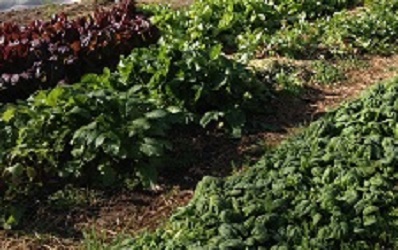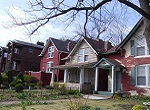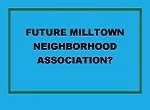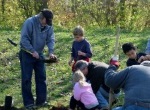Start a Community Garden for Fun, Food, Beauty, Belonging
Last Updated: May 18, 2024
It is popular now in the U.S. to start a community garden, although of course it is just normal in tribal cultures. On this page we give you some tips to reduce the frustrations some people encounter in this task.

In our community development practice, we observe that growing food locally has become a
trend because:
- Urban dwellers want to be green and reconnect with nature.
- Many people want to grow some food to save money.
- Folks would like to grow organically, that is, grow food without the use of pesticides and chemicals.
- Everything from chemical scares to worries about terrorism have people thinking that they should learn something about growing food "just in case" something bad happens.
- People interested in sustainability realize that locally grown food reduces the carbon footprint of their diet. Otherwise produce is imported from Chile or Mexico, if you live in the U.S., or vice versa.
- Locally grown food can serve as landscaping or make vacant land in areas of low real estate demand seem attractive and productive again.
- Lower-income neighborhoods typically have become "food deserts." If you don't know the term, it means a place without grocery stores or places to buy a wide spectrum of foods. Since convenience stores are unlikely to sell a variety of produce, healthy food advocates are particularly keen on introducing gardening within such neighborhoods.
- When fear of disease is present, as in the coronavirus pandemic, uncertainty about conditions in the food supply chain makes many of us want to be able to see where our food is grown.
- Neighbors actually socialize and get to know one another when they start a community garden. This increase in community feeling brings benefits far beyond food production.
- Parents, grandparents, and community leaders worry that children have no idea how food is grown and do not appreciate both the work and the wonder involved in growing food.
Gardening itself is an enormously popular hobby in the United States. The idea of cooperating with others to do something you could not or would not do by yourself promotes community.
You can even help expand the notion of community in your neighborhood by recruiting young and old of different social classes and ethnicities to cooperate together on this project. In our experience, after a few awkward moments at the beginning, the joint project leads to fun and the potential for relationship building.
The concept of urban agriculture or urban farming is just edgy and novel enough to appeal to urban trend-setters and young people concerned about climate change too. Especially in cities that have lost population and are seeking new productive uses for the land that once was required for housing, this idea is a winner. It's not a panacea for everything wrong with distressed cities, but it is a great stopgap measure.
Gardening Together In the Suburbs
Often in suburbs, the construction process has compacted the soil so much that the soil in backyards isn't particularly suitable for gardening.
The land might require quite a bit of augmentation and probably some new topsoil. Be prepared for the work and expense of preparing a suitable plot of land.
For good locations for your community garden, check on unsold lots in your subdivision or an extra lot that a next door neighbor has purchased. In many places parks departments are open to the idea of leasing space to a community garden at no cost, so be sure to look for a viable partnership there. In other locations schools also are delighted to welcome adult community members to join the children in learning to grow food and flowers.
When You Start a Community Garden In the Urban Core
In the urban core, before you start a community garden, you often must educate neighbors and the youth and children about nutritious foods and their preparation. The children don't know how a carrot grows (below the ground, although the tops above-ground are good-looking).
They might not even know what a really fresh carrot tastes like. Honey buns are much more available at the corner convenience store.
Many urban adults have no experience with any exotic vegetables at all. If it isn't yams, potatoes, green beans, or sweet corn, forget it.
The African-American community likes greens, but it's interesting to me that many of the children don't know how they grow, even if the parents and grandparents can prepare really wonderful concoctions when they have access to raw greens.
So you have to teach people what to do if they have a zucchini or cantaloupe given to them. Not to mention you have to teach them how and when to plant them. (Here's a hint: zucchini and cucumber take some room).
In an urban or suburban setting, find or start an organization to provide the basic level of information about what plants are likely to be successful in an urban setting, what should be planted when, what plants like to be wet, which ones tolerate drought and heat, how far apart the rows should be, what pests are likely to attack you and when, and so forth.
Have your soil tested for contaminants, especially lead. If you live around a major highway or industry, it's likely your soil has elevated lead levels or maybe other heavy metals.
What level of contamination is too much? Talk to your urban extension agent, who likely is the gatekeeper for free or very inexpensive tests (probably less than $25). The results also will give you some clues about how to add things amend the soil, if you decided to go that direction.
If you can't afford testing, another option might be to use all raised
beds made with scrap lumber and clean soil. Cut down on the cost of that by using compost
you make yourself, although be careful not to introduce weed seeds and contaminants into your compost bin. But do investigate the true cost of testing, as compared to having to buy any lumber, soil, or compost.
If you want to scale up to grow more food, then think about an urban farm with
community-supported agriculture or subscription farms, as they may be
called in various places. The initials CSA also are used to describe this system.
The idea of a CSA is that households that don't want to garden themselves subscribe
in advance to pay a certain amount for a basketful of whatever produce
is ready for delivery in a particular week. Usually there is a common
pick-up point, but sometimes home delivery is included. Depending on your location, you actually might grow enough food for the gardeners and CSA members plus still make a small profit. The U.S. Department of Agriculture has compiled this useful list of resources for CSAs.
Small Town Community Gardening
In a small town, it is quite likely that the lore of how to garden with vegetables and flowers is not totally lost.
Ask around; you might be surprised who knows what. These
long-lost lessons from childhood can be recovered, and chances are, it
will actually be fun for the people who have this knowledge to share it. They likely will help to start a community garden, even if they thought they would never do that much hard work to grow food again. If you are really in need of advice, you are likely to find people willing to share their wisdom even if they refuse to pick up a hoe to help out.
The veteran gardeners who haven't planted anything for a while will be amazed at the new hybrids, wider diversity of seeds, something called heirloom tomatoes, and the possibility of growing herbs.
Small towns also offer a number of opportunities for multiple problem-solving when you start a community garden. If you have an old concrete or asphalt pad from a parking lot or a demolished building, this is a good time to rip it out and to reclaim the land for future uses. Until there is specific demand for those uses, however, your community garden might fill that space attractively.
In addition, the removal of impervious surfaces (surfaces that water cannot penetrate) would help reduce the stormwater runoff burden and possibility of flash flooding.
Community gardens also are a convenient replacement for vacant land or for an eyesore. They may even grace a public park if your park doesn't seem to have a real purpose now.
I myself never want to snap another green bean, shell another pea, or seed another cherry, but I've come to understand that I'm actually an exception. I do crave a real-tasting tomato and strawberry, and probably so do many of you.
Organizing for Minimal Conflict As You Start a Community Garden
Some earnest conversations are in order before jumping into a community garden project. If you thoroughly discuss possible incompatible visions for the garden, you will avoid the long, enduring conflicts that drag any human collaboration down. These are the questions to ask:
- Is your community garden simply a place where individual households are assigned to a specific area or row, tend that themselves, and harvest that themselves, or on the other hand, is it a place where people divide up the work and the food and flowers produced?
- Shall we plant food-bearing plants, or is the garden for producing flowers, or both?
- How will we decide what to plant?
- How are planting expenses divided up?
- Are people "members" of the community garden, or is everyone in the neighborhood automatically entitled to be involved as much or as little as they would like?
- Must people work in the garden to harvest from the garden?
- What are the rules about harvesting food, flowers, and herbs that were planted by others?
- Who's checking your progress on a daily basis, so that the weeds and pests don’t take over? And who's watering? What will be your water source, and do you have required permission if you plan to use a city fire hydrant or other public source?
- How will tools be obtained, and how will they be secured on or very near the site? Or must everyone bring their own tools each time they come to the garden?
- Who can advise us if we're having difficulty with plant selection, soils, watering systems, pests, and so forth?
- Will there be any effort to sell the surplus produce, plants, or flowers? If so, what would be the best outlet, and who will be responsible for making the decision about what is excess? How would the revenue be divided up?
- Will shade, drinking water, and a place to sit be available on the site? If not, how will that impact the ground rules? Will these inconveniences influence your ability to retain gardeners?
- If you will be leasing your garden space from a public entity, such as a city or a park, who will be responsible for staying in contact with the local government and making sure you have any required signed documents?
And if you need a little more advice as you start a community garden, check for a local group or the many resources of the American Community Gardening Association. Other helpful organizations are the Community Gardens as Appleseeds Foundation, which may provide minor cash to help with gardens, and the National Gardening Association for general gardening advice. And for an all-inclusive approach to a wonderful neighborhoods, we recommend the book The Great Neighborhood Book: A Do-It-Yourself Guide to Placemaking. Your garden can really make an area distinctive, help improve communication and collaboration among generations, and represent a tangible neighborhood accomplishment, whether you are a well-established community or one that is struggling.
If you envision a really extensive or fancy community garden, you may need to read about how to start a community-based non-profit organization. However, the vast majority of community gardens are not incorporated, and many are not connected formally to any neighborhood association or community development corporation.
Learn From These Helpful Resources for Thinking Through Community Projects
We have found that organizing people to create a community garden is similar to many other community development projects. If you haven't ever tried to get people who don't necessarily know one another to work together, you might want to read some words of wisdom from our experiences with helping people to start block units or neighborhood associations. Feel free to use the search feature for this website when problems arise, as they will. But the rewards usually far outweigh the challenges.
- Making and Keeping a Good Community >
- Community Improvement Projects > Start a Community Garden
Join GOOD COMMUNITY PLUS, which provides you monthly with short features or tips about timely topics for neighborhoods, towns and cities, community organizations, and rural or small town environments. Unsubscribe any time. Give it a try.



